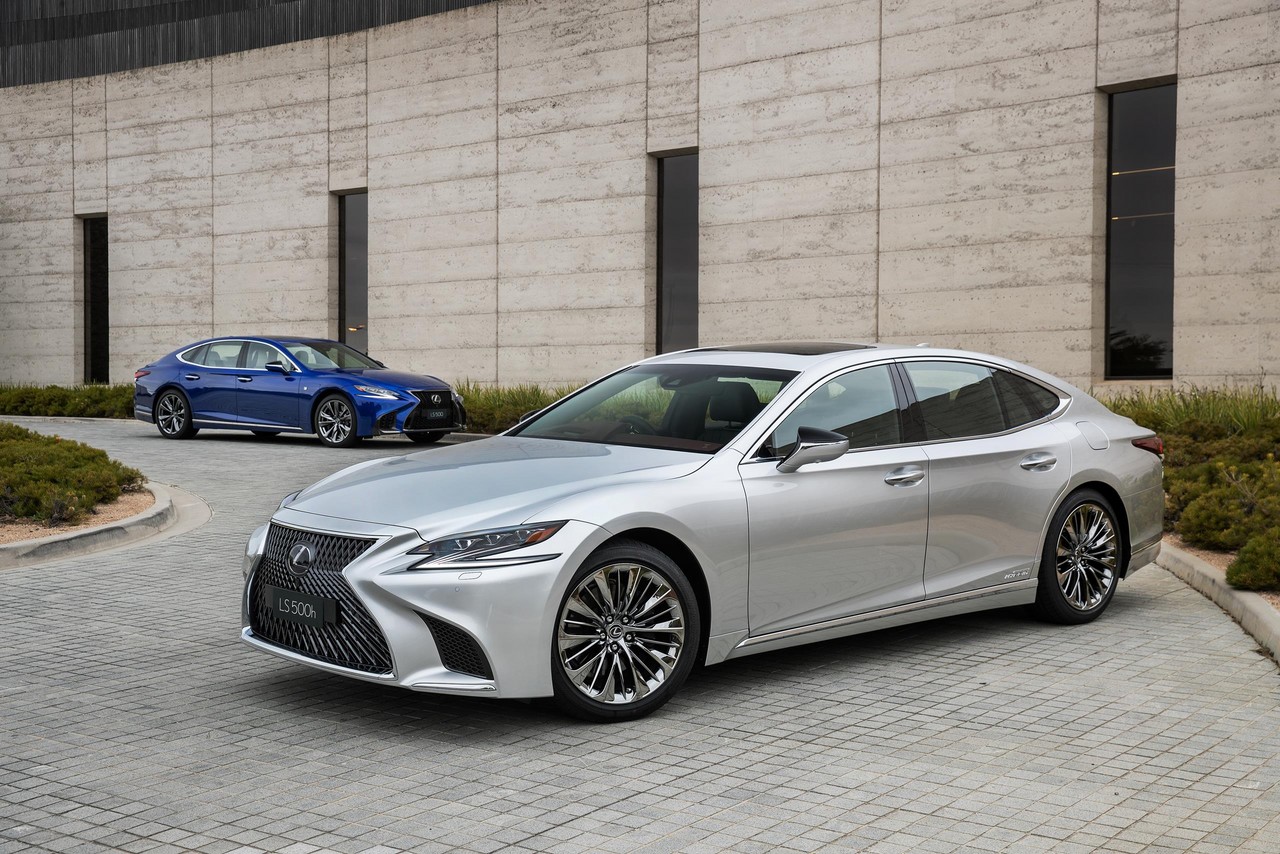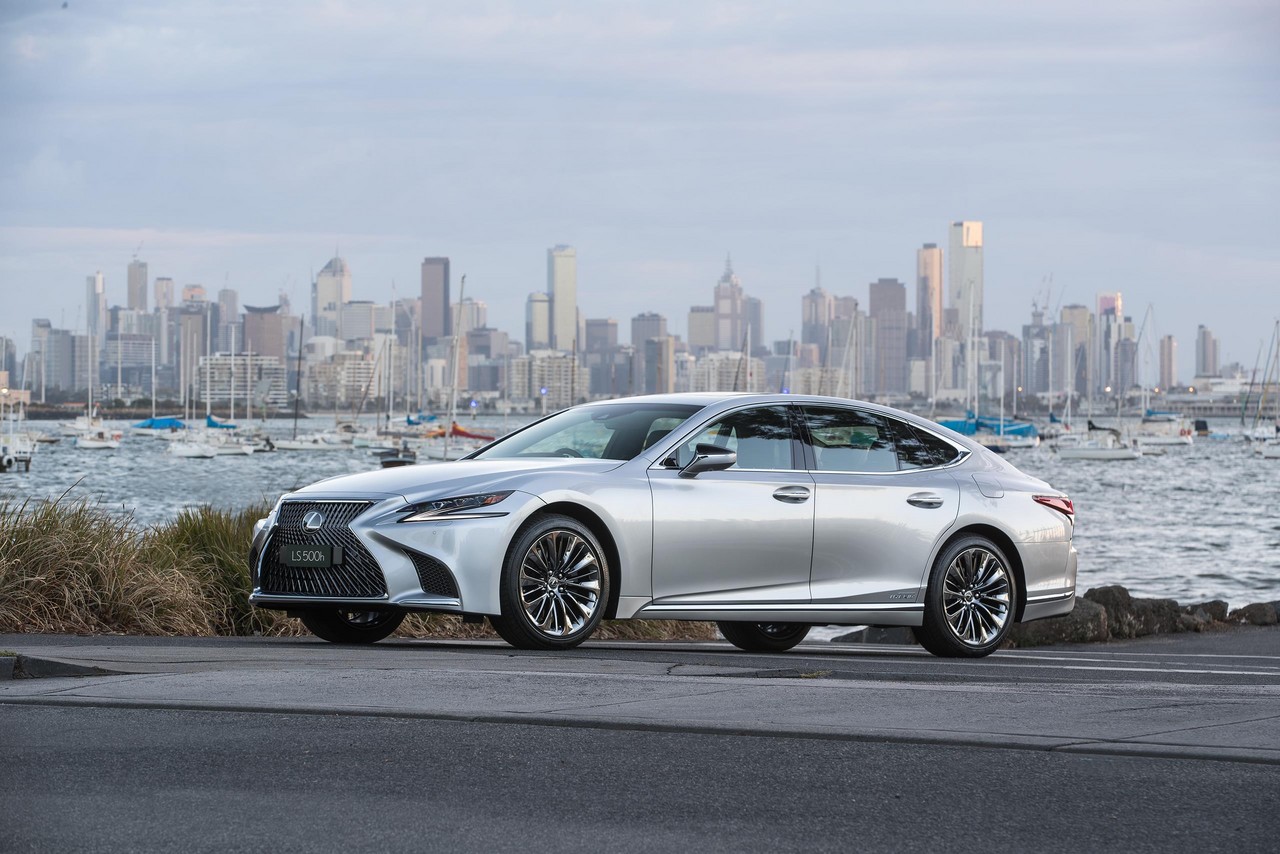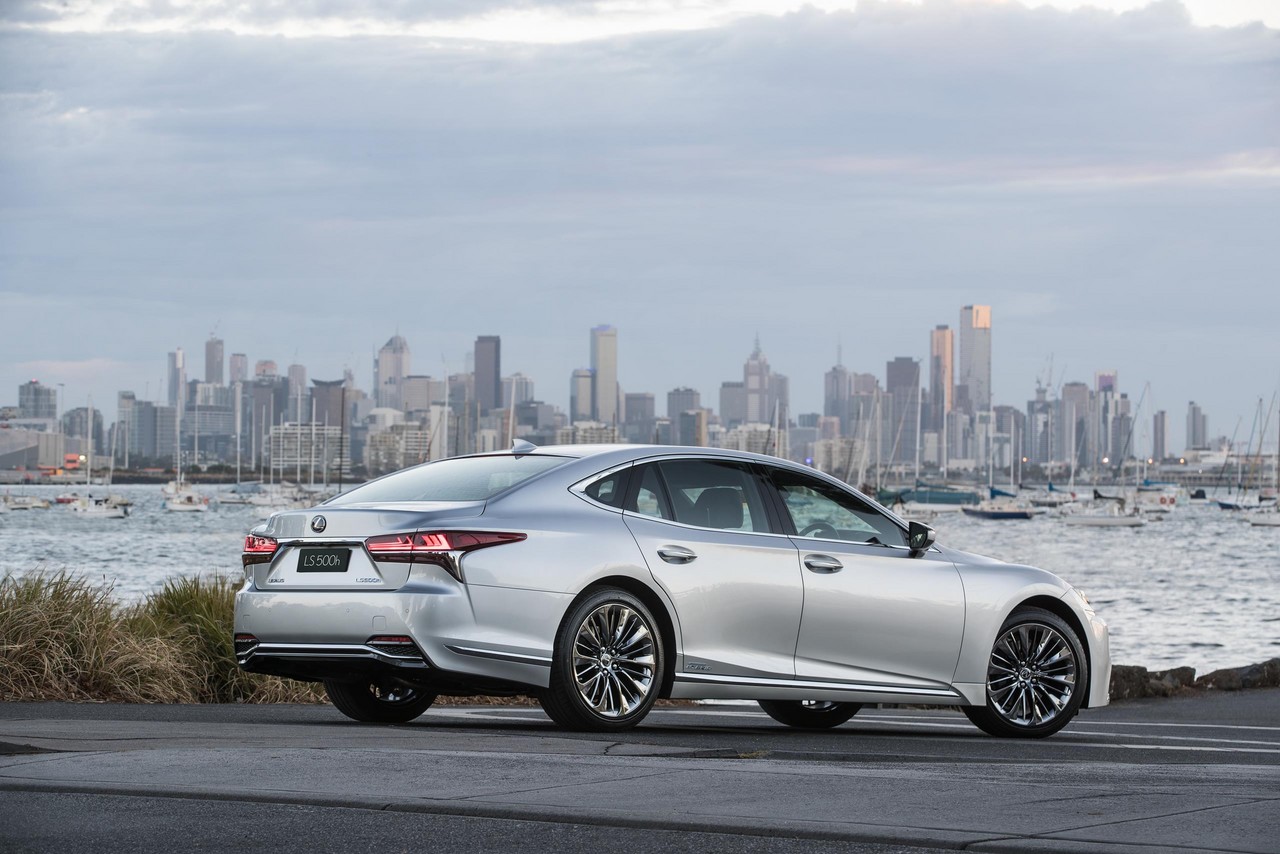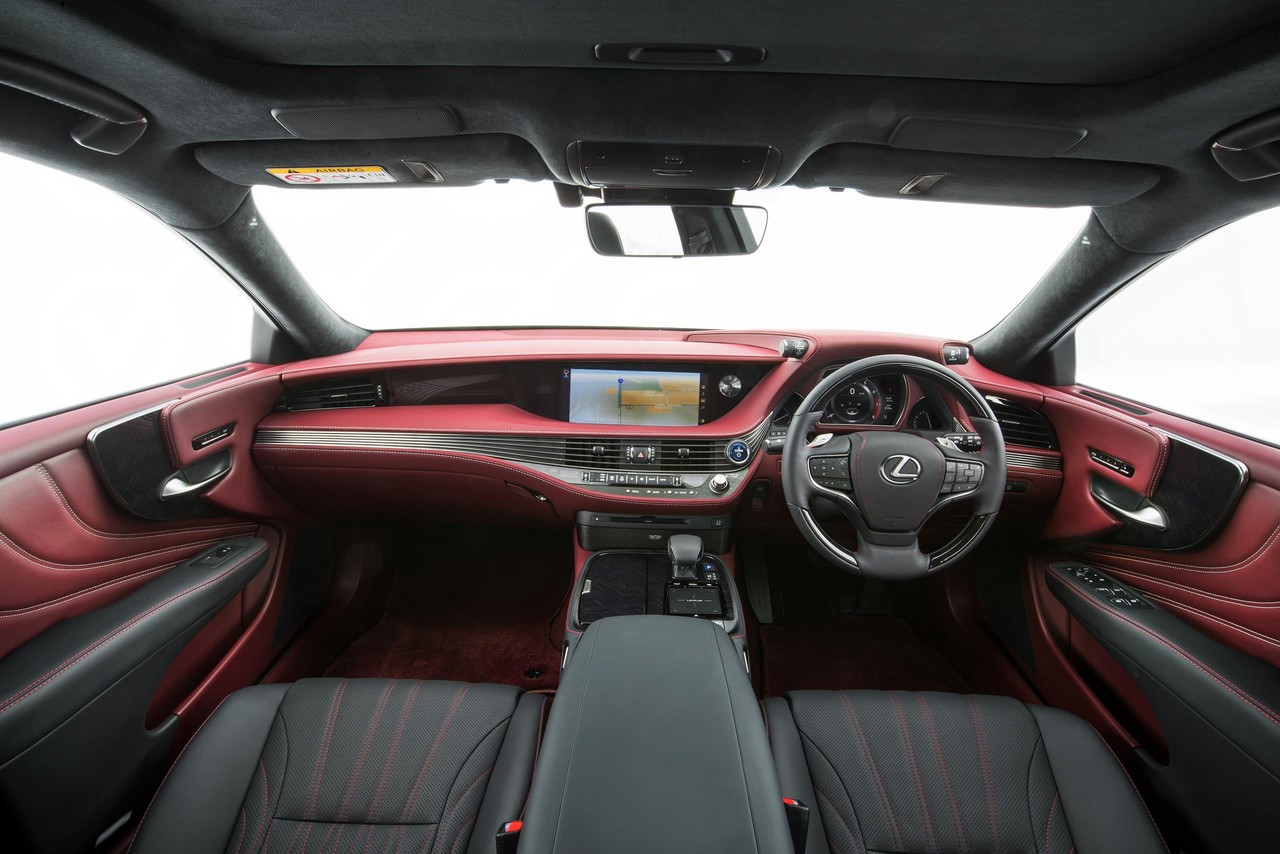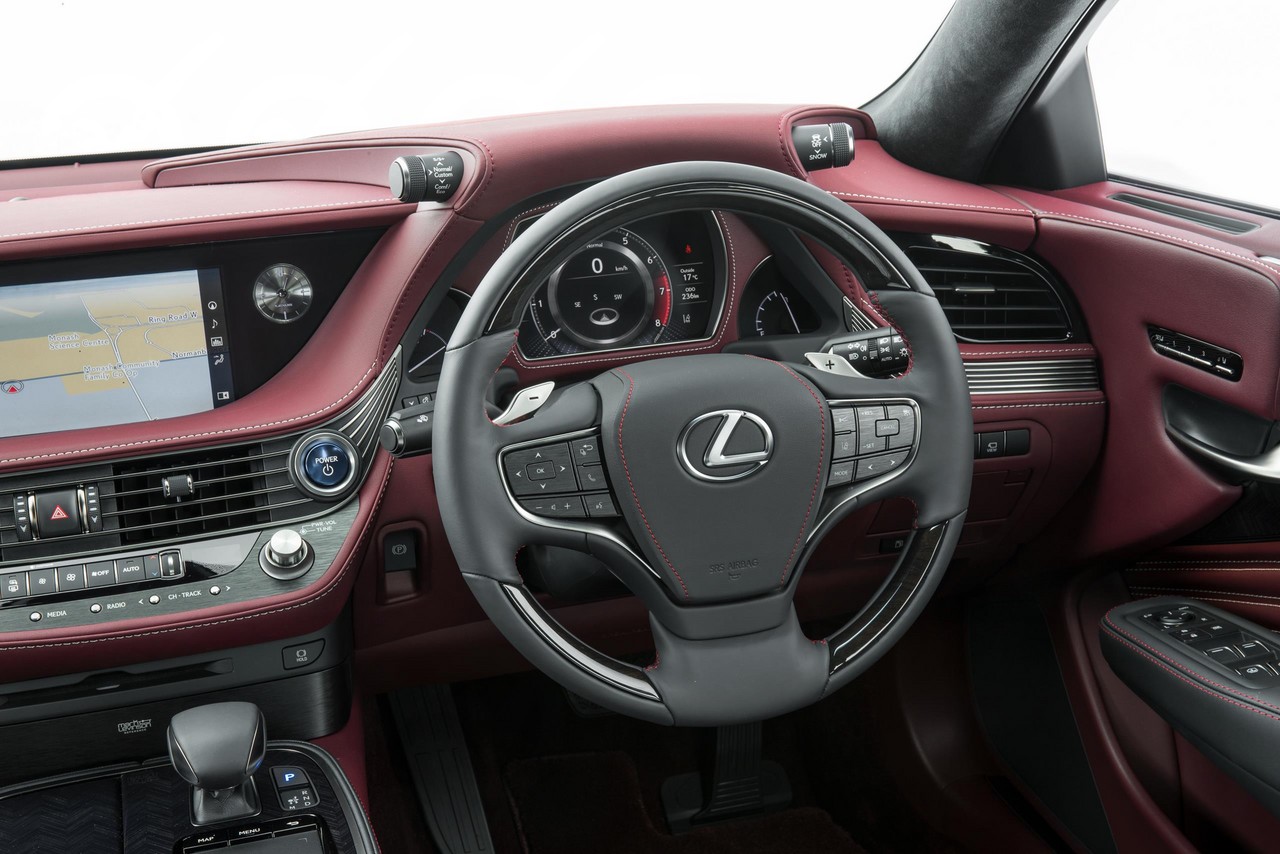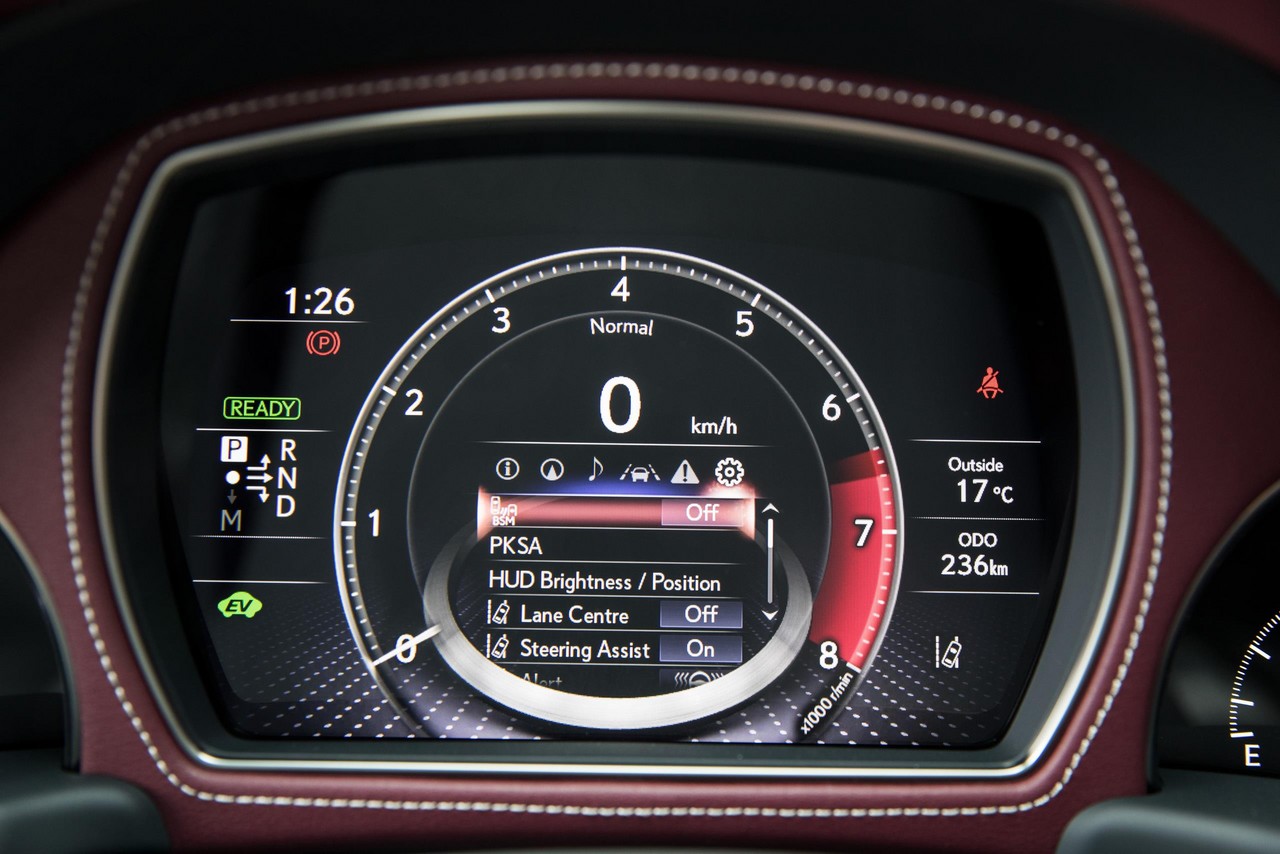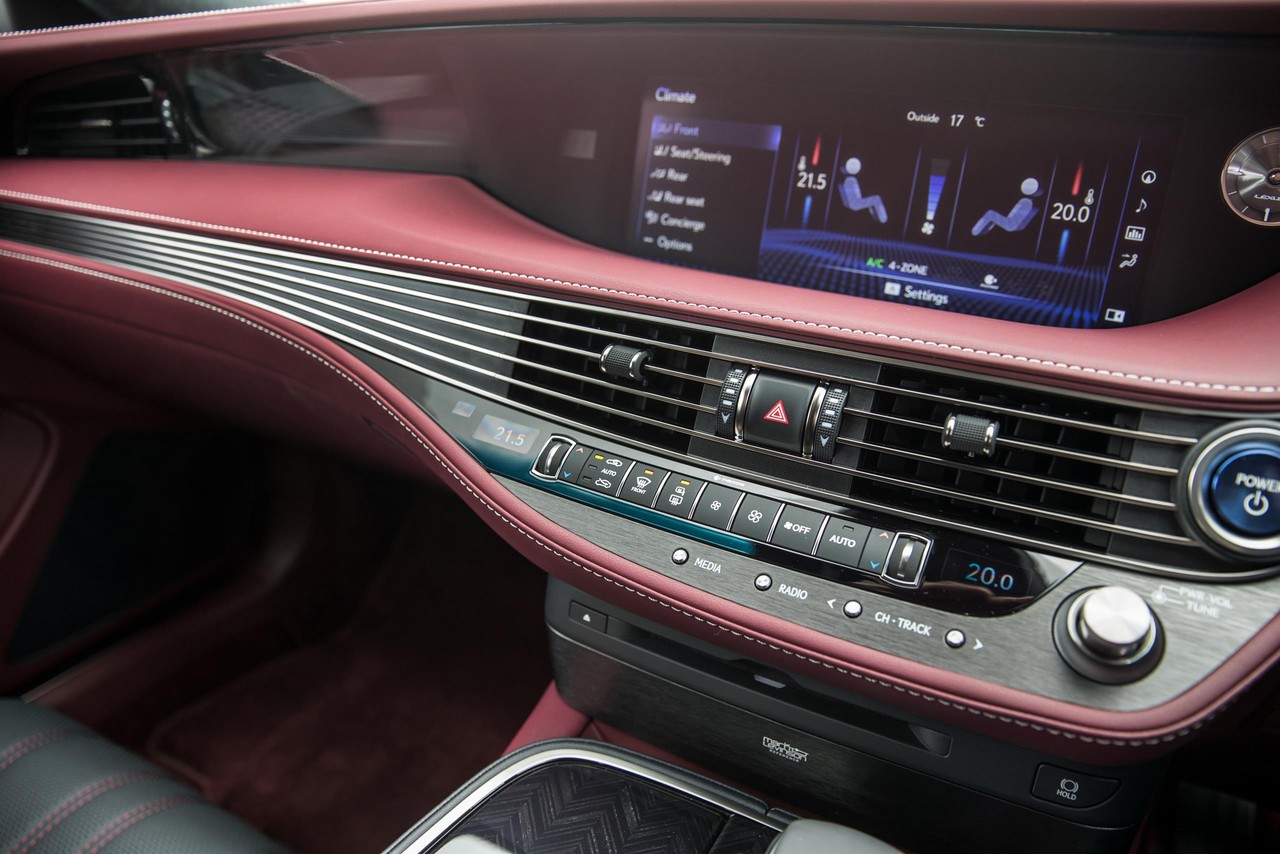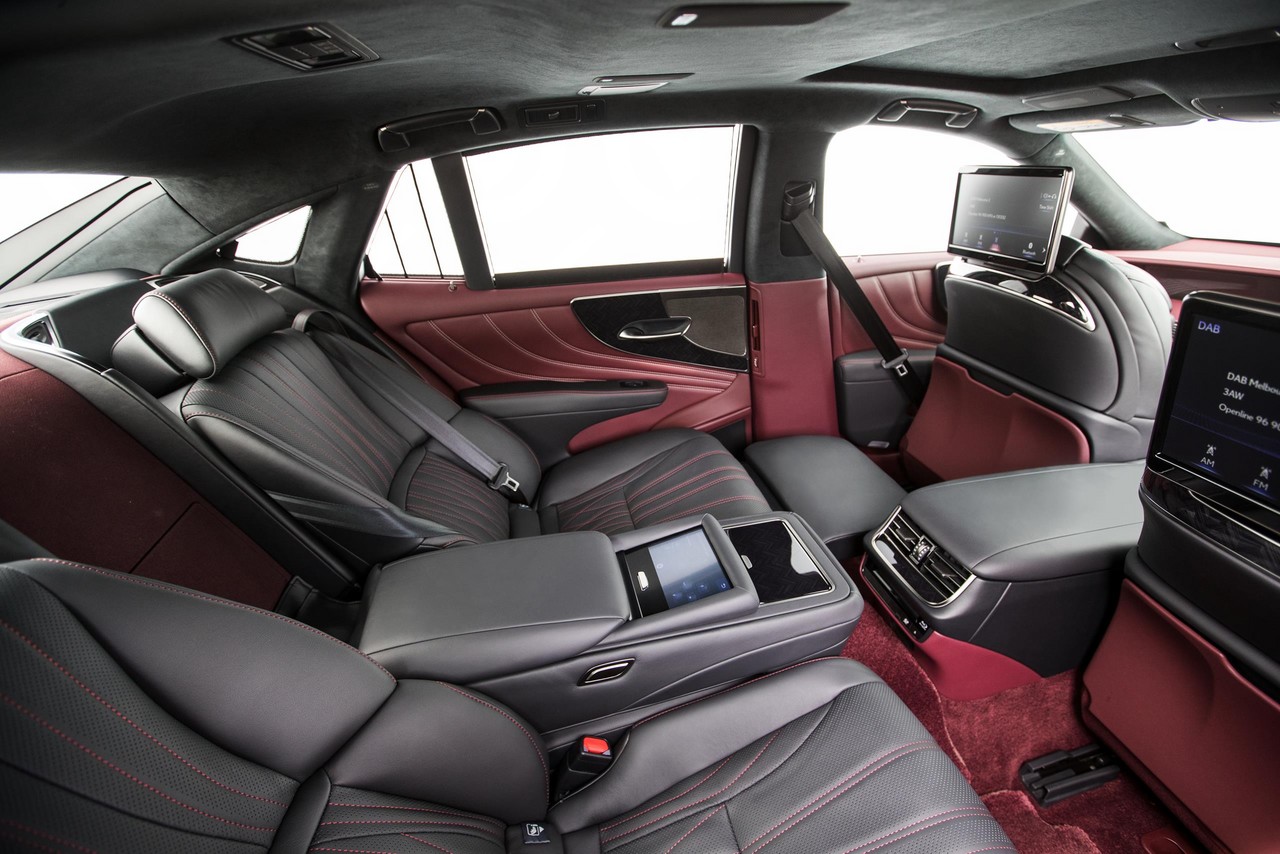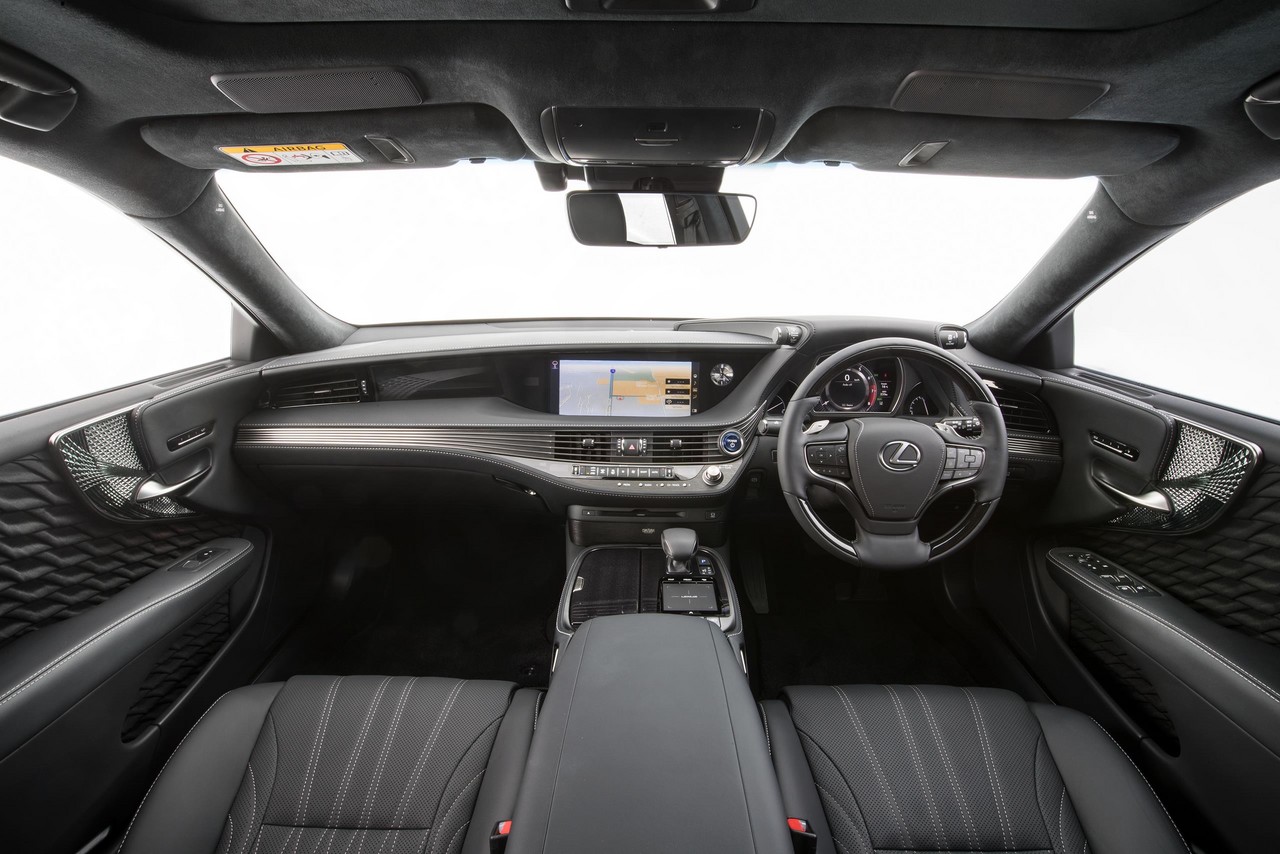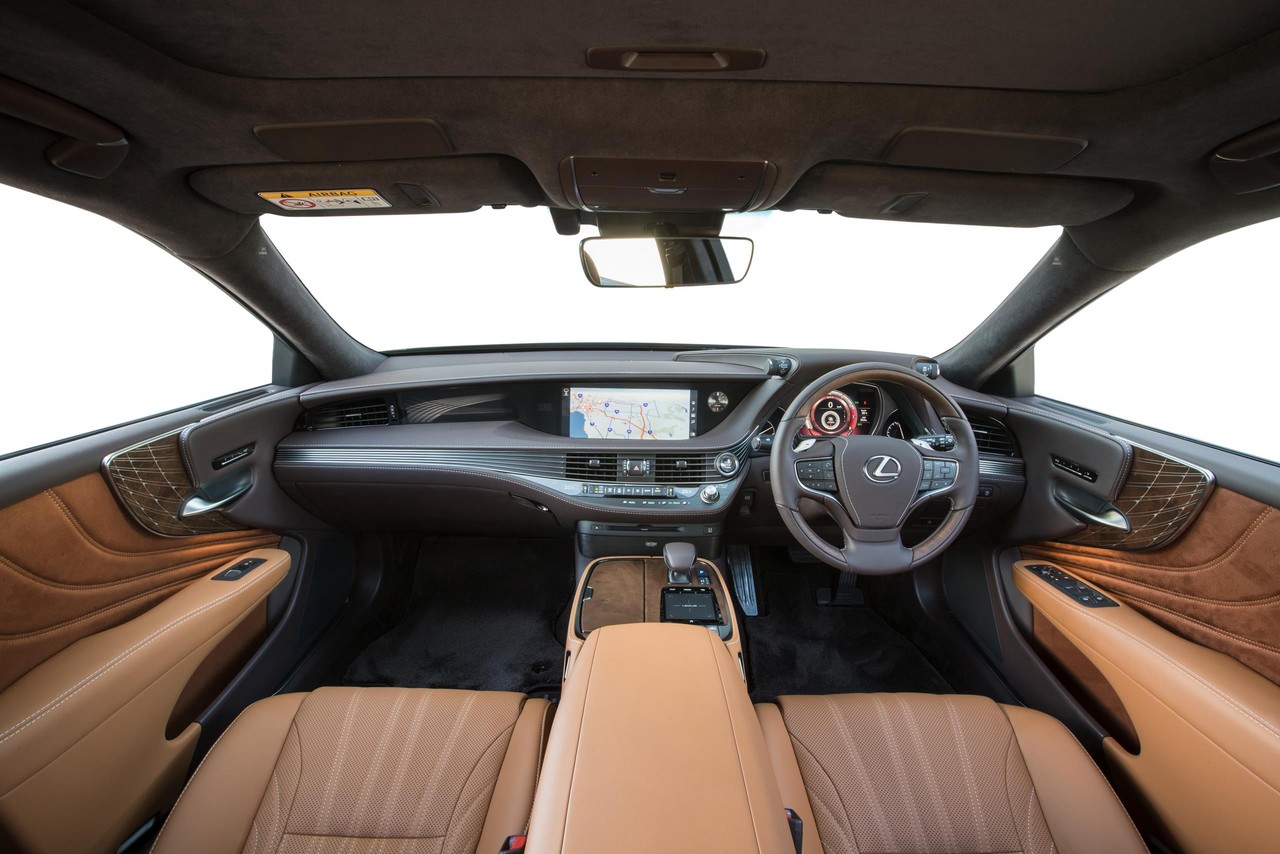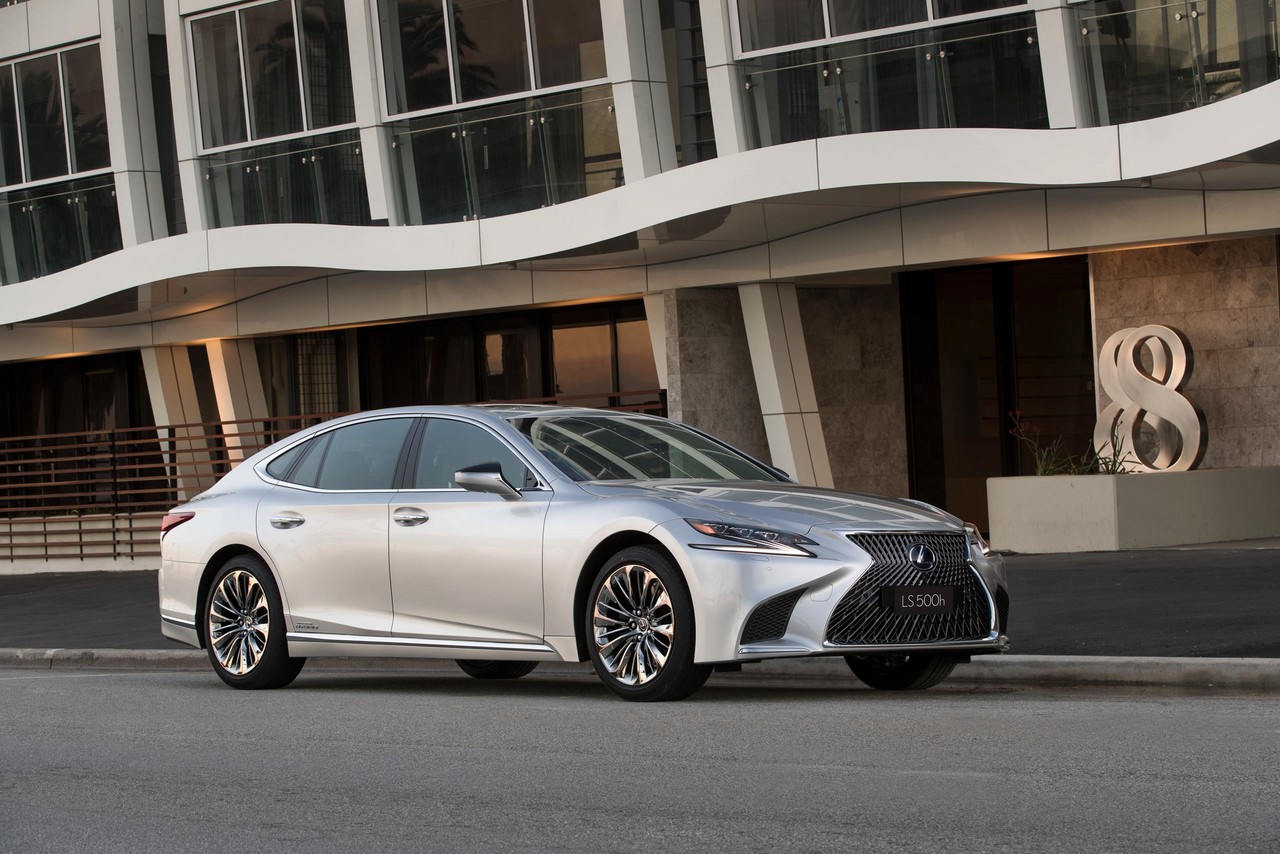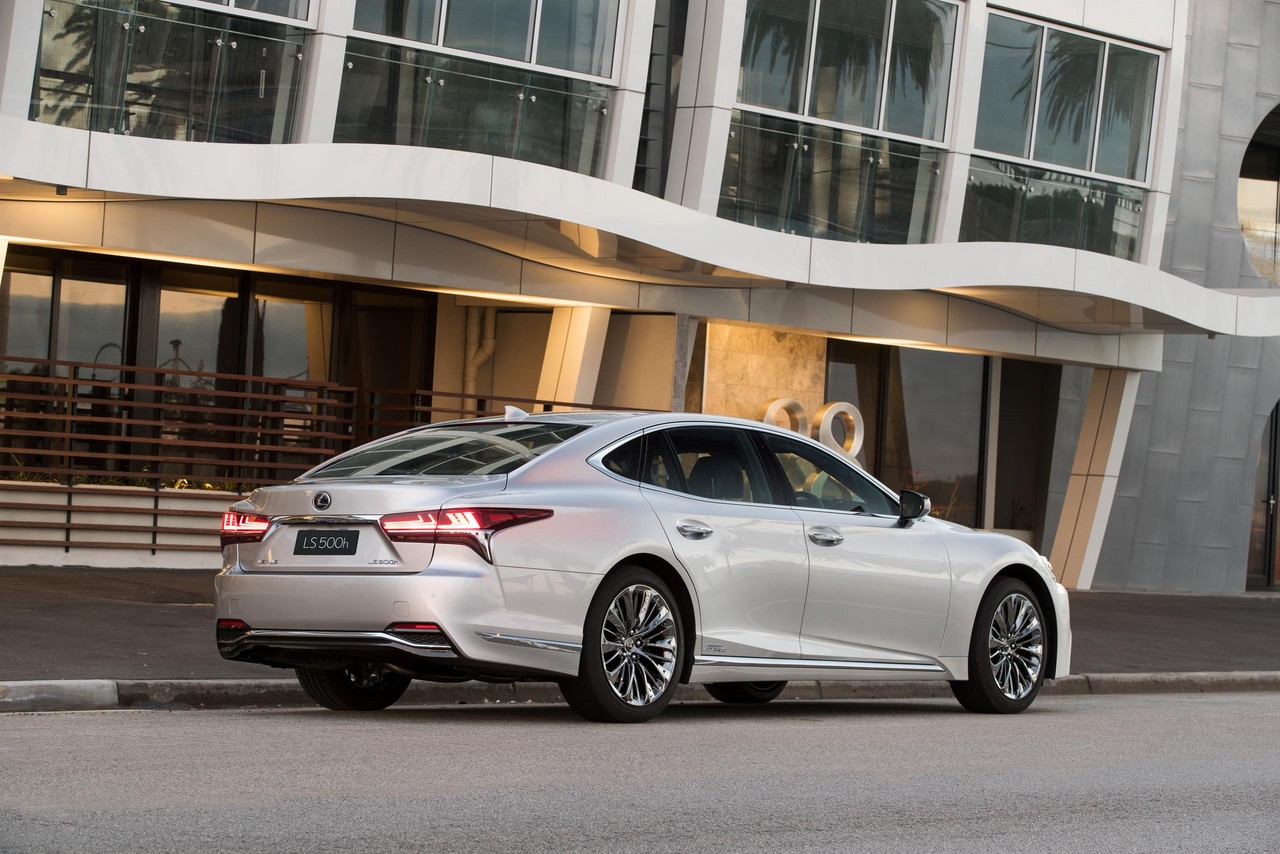
- For LS 500, responsive 3.5-litre biturbo V6 engine and 10sp auto
- Air suspension and adaptive dampers provide comfortable ride
- Awesome interior craftsmanship and materials
- Quiet, well-insulated cabin
- Supremely adjustable front and rear seats
- For LS 500h, hybrid system lacks low-rev torque and CVT can drone
- For Sports Luxury variants, body roll when cornering (no active anti-roll bars)
- Light steering lacks feel
- Limited rear headroom for a limousine (at 190 cm, your hair will brush the headlining)
- Lexus Remote Touch system not intuitive to use
- Small boot capacity
- No reason why Sports Luxury variants have an inferior braking system to F Sport variants
Overview
Released in Australia in April 2018, the fifth-generation Lexus XF50 LS was a long wheelbase executive sedan. Manufactured in Tahara, Japan, the Lexus XF50 LS range consisted of LS 500 and LS 500h models (see table below).
Lexus LS 500: V35A-FTS engine
For the Lexus LS 500, the biturbo 3444 cc V35A-FTS engine had an aluminium alloy block with a 60-degree ‘V’ angle, 85.5 mm bores and a 100 mm stroke. Beyond this, the aluminium alloy cylinder head had double overhead camshafts and four valves per cylinder, including laser-clad intake valve seats. For the intake valves, the ‘VVT-iE’ camshaft timing used an electric motor to vary the VVT-i controller for camshaft advance or retard. In contrast, the exhaust camshaft had a conventional hydraulic VVT-i system in which the camshaft timing oil control valve (OCV) controlled a spool valve so that hydraulic pressure could be applied to the advance or retard side of the VVT-i controller. In response, rotation of the VVT-i controller vane sub-assembly (relative to the timing chain sprocket) varied valve timing.
Other features of the V35A-FTS engine included its electrically actuated wastegates, port injection (EFI) and direct injection (Toyota’s D-4ST) via six-hole injectors, compression ratio of 10.5:1 and maximum thermal efficiency of 37 per cent. The V35A-FTS engine required 95 RON premium unleaded pressure and enabled the LS 500 to accelerate from rest to 100 km/h in 5.0 seconds.
Lexus LS 500h: 8GR-FXS engine
Shared its with the Lexus LC 500h , the 3456 cc 8GR-FXS engine had a die-cast aluminium alloy block, an aluminium alloy cylinder head mounted on a steel-laminate type head gasket, a forged steel crankshaft with five balance weights, forged connecting rods, aluminium alloy pistons, double overhead camshafts (chain driven), four valves per cylinder actuated by roller rocker arms, D-4S injection (see above), an exhaust manifold that was integrated into the cylinder head, and a compression ratio of 13.0:1. Maximum engine speed for the 8GR-FKS engine was 6600 rpm.
While the exhaust camshaft for the 8GR-FXS engine enabled variable exhaust valve timing (VVT-i), the intake camshaft had a mid-position camshaft lock mechanism which could retard intake valve timing – known as ‘Variable Valve Timing – Intelligent Wide’ (VVT-iW) – which enabled the 8GR-FXS engine to:
- Start in the Otto cycle;
- Switch to an Atkinson cycle (i.e. shortened compression stroke and longer expansion stroke) for low-rev operations to minimise fuel consumption; and,
- Use an Otto cycle at higher engine speeds for greater power.
For the LS 500h, the 8GR-FXS engine was combined with a permanent magnet synchronous motor that drew power from 44.6 kW lithium-ion battery which had 84 cells and a nominal voltage of 310.8 volts. The LS 500h required 95 RON premium unleaded petrol and complied with Euro 6 emissions standards.
The LS 500h could accelerate from ret to 100 km/h in 5.4 seconds
| Engine | Trans. | Peak power | Peak torque | |
|---|---|---|---|---|
| LS 500 | 3444 cc V35A-FTS twin turbo petrol V6 | 10sp auto (AGA0) |
310 kW at 6000 rpm | 600 Nm at 1600-4800 rpm |
| LS 500h | 3.5-litre 8GR-FXS petrol V6 | CVT + 4sp auto (L310) |
220 kW at 6600 rpm | 350 Nm at 5100 rpm |
| Permanent magnet synchronous motor | 132 kW | 300 Nm | ||
| Combined | 264 kW | N/A | ||
Body and dimensions
The Lexus XF50 LS was underpinned by Lexus’ global architecture for luxury vehicles, GA-L, which was shared with the Lexus LC . Compared to the Lexus XF40 LS , the XF50 LS was 85 mm longer (at 5235 mm), 25 mm wider (1900 mm), 15 mm lower (1450 mm) and had a 35 mm longer wheelbase (3125 mm). The Lexus XF50 LS 500 and LS 500h had drag co-efficients of 0.29 Cd and 0.28 Cd, respectively.
Relative to the XF40 LS, the body of the Lexus XF50 LS was around 90 kg lighter due to the use of lightweight materials – this included ultra-high tensile hot stamped steel for nearly 30 per cent of the body by mass and aluminium for the bonnet, front fenders, door skins and boot lid. For the XF50 LS 500, unladen mass ranged from 2075 kg to 2235 kg; for the LS 500h, unladen mass ranged from 2150 kg to 2295 kg. For greater rigidity, the XF50 LS also had braces in the engine compartment and stiffer cast-aluminium suspension towers.
Suspension
The Lexus XF50 LS had multi-link suspension front and rear. The front suspension had double ball joints on the upper and lower control arms, with all but one of the control arms made from forged aluminium. As standard, the Lexus XF50 LS had:
- Adaptive Variable Suspension (AVS) which controlled shock absorber damping force on all four wheels based on g forces, yaw and speed. According to Lexus, the linear solenoid actuators were capable of 650 damping force switching levels; and,
- Air suspension which used compressed air that was stored in a pneumatic tank for faster height adjustment. Furthermore, an ‘access function’ could raise the height of vehicle when it was unlocked with the smart key.
Unique within the range, the Lexus XF50 LS F Sport had active stabiliser bars that reduced body roll when cornering to enhance cornering stability.
Steering
The Lexus LS had rack-and-pinion steering with electric power assistance. While the LS Sports Luxury had a minimum turning circle of 11.4 metres, the turning circle for the LS F Sport was 11.2 metres.
Unique within the range, the Lexus LS F Sport had:
- Variable Gear Ratio Steering (VGRS) which varied the steering ratio according to vehicle speed and steering operation. As such, the steering ratio varied lock-to-lock turns between 2.3 and 3.3; and,
- Dynamic Rear Steering (DRS) which could turn the rear wheels to complement the driving situation. At speeds of up to 80 km/h, DRS turned the rear wheels in the opposite direction to the front wheels for tighter turns. At speeds above 80 km/h, the rear wheels turned in the same direction as the front wheels for greater stability.
Safety equipment
Standard safety equipment for the Lexus XF50 LS included dual front airbags, dual front knee airbags, front and rear side airbags, full-length curtain airbags (i.e. for front and rear occupants), ABS, electronic brake force distribution, brake assist, electronic stability control, traction control and front seatbelts with pre-tensioners and load limiters. The Lexus LS Sports Luxury also had rear-seat cushion airbags to prevent the rear passengers from sliding beneath their seatbelts during a collision.
As standard, the Lexus XF50 LS was equipped with the ‘Lexus Safety System +’ which included:
- Lexus’ Pre-Collision Safety System (PCS): used a grille-mounted radar sensor and forward recognition camera to detect potential collision hazards. If detected, the driver would initially receive a warning and Pre-Collision Brake Assist (PBA) would activate to increase braking force. If the relative speed between the driver’s vehicle and the obstacle ahead exceeded 30 km/h, PBA would automatically apply the brakes to reduce vehicle speed by up to 40 km/h and reduce the severity of a collision;
- All-speed Active Cruise Control (ACC): used a millimetre-wave radar to detect vehicles ahead and determine their speed. Adaptive Cruise Control could then adjust vehicle speed – within a set range – to maintain a safe distance to the vehicle ahead;
- Lane Departure Warning (LDW) and Lane Keeping Assist (LKA): used a millimetre-wave radar and camera to monitor the vehicle’s position within its lane. If the driver unintentionally drifted out of their lane, LDW provided a warning via steering wheel vibrations and an audible tone. If ACC was active, Lane Keeping Assist (LKA) could apply counter-steering to keep the Lexus LS within its lane;
- Sway Warning System (SWS): monitored the vehicle’s position within the lane and the driver’s steering to detect sway, which could be caused by driver fatigue or inattention. If detected, the system would alert the driver by sounding a buzzer and displaying a warning on the multi-information display; and,
- Adaptive High-beam System (AHS): could detect the headlamps of oncoming vehicles and tail lamps of preceding vehicles. If other vehicles were detected, AHS would selectively disable the LEDs in the headlight units so that they did not directly project onto a preceding or oncoming vehicle.
As standard, the Lexus XF50 LS also had:
- A Blind Spot Monitor (BSM): once vehicle speed exceeded 40 km/h, sensors in the rear bumper could detect vehicles in the adjacent lanes. If the driver indicated to change lanes and a vehicle was detected, a warning tone would sound. The BSM could detect vehicles larger than an average 125 cc motorcycle and where the relative speed difference was up to 28 km/h;
- Rear cross-traffic alert: when reversing at speeds below 8 km/h, sensors in the rear bumper could detect approaching traffic travelling at speeds from 8 km/h to 28 km/h which may cross the vehicle’s intended path. If crossing traffic was detected, a warning tone would sound; and,
- Rear Camera Detection: used the rear camera and rear-mounted radar sensors to detect pedestrians when parking. If detected, the driver would be alerted by an indicator in the centre display and a buzzer.
From November 2018 deliveries, the Lexus LS was equipped with the following safety technologies –
- Pedestrian alert: if a possible frontal collision with a pedestrian was assessed, the position of the pedestrian would be shown in an animated graphic on the vehicle’s head-up display to assist the driver’s recognition of the situation;
- Active steering assist: operated when there was a high possibility of collision with a pedestrian in the lane of travel or with continuous structures such as a guardrail. In the system determine that brake control alone would be insufficient to avoid a collision, steering assistance would be provided in addition to activating an alert and applying the brakes. When active steering assist was activated, however, the vehicle would only move within a clearly marked lane;
- Lateral side radar pre-collision: could detect vehicles approaching diagonally at up to 50 metres in front of the Lexus LS. If detected, the driver would be alerted via the head-up display and brake assist may also be activated;
- Lane Tracing Assist (LTA): an extension of the Lane Departure Warning system, LTA monitored the path of the vehicle ahead where there were no road or lane lines that could be detected. As such, LTA could determine when the Lexus LS had deviated from the path of the vehicle ahead and may be in danger of leaving the road; and,
- Road-sign assist: used a camera to acquire speed-limit information which was the presented on the Lexus LS’s head-up and multi-information displays.
The Lexus LS Sports Luxury was also equipped with ‘front cross-traffic alert’ which used ‘side-scanning’ radar sensors to detect vehicles or bicycles up to seven (7) metres from the front of the Lexus LS and travelling at speeds between 10 km/h and 60 km/h. if detected, the driver would be alerted via the head-up display.
Finally, the Lexus LS had an ‘active’ bonnet that would rise in the event of a pedestrian collision to provide additional deformation space over hard structures in the engine compartment.
Wheels, tyres and brakes
The Lexus XF50 LS Sports Luxury had 20 x 8.5J front wheels with 245/45 RF20 tyres and 20 x 8.5J rear wheels with 245/45 R20 runflat tyres; for the LS Sports Luxury, the wheels had a hollow-rim structure to reduce resonant sounds generated by the tyres. The LS F Sport differed, however, in that it had 20 x 9.0J rear wheels with 275/40 R20 runflat tyres.
The standard braking package for the Lexus XF50 LS consisted of 357 mm by 34 mm ventilated front brake discs with four-piston callipers and 335 mm by 25 mm ventilated rear discs with two-piston callipers. The Lexus LS F Sport, however, had 400 mm by 36 mm ventilated front brake discs with six-piston monoblock front callipers and 359 mm by 30 mm ventilated rear discs with four-piston monoblock rear callipers.
Features: Lexus LS F Sport
The standard multi-media system for the Lexus XF50 LS included the ‘Lexus Premium Navigation’ system with a 12.3-inch multi-media display, Remote Touch Interface control, DVD player, digital radio (DAB) tuner, four USB ports (two front and two rear), 3.5 mm auxiliary-in socket and Bluetooth mobile phone connectivity. Furthermore, the Mark Levinson 3D QLI (Quantum Logic Immersion) Reference Surround Sound System provided 7.1-channel surround sound through twenty-three (23) speakers in sixteen locations (including dual 40 mm in-ceiling speakers positioned above the seats) with a maximum output of 2400 watts.
Standard features for the Lexus LS F Sport dual-zone climate control air conditioning, ‘F Sport’ seats with twenty-eight (28) way power/pneumatic adjustment, heated and ventilated front seats, heated rear seats, ‘smooth’ leather upholstery, LED headlights and LED daytime running lights, front fog lights, dusk-sensing headlights, rain-sensing wipers, front and rear parking sensors, remote central locking with proximity key, power adjustable and heated door mirrors with auto-dimming and auto-folding functions, power windows, a power adjustable steering wheel (height and reach) with memory settings, an auto-dimming rear-view mirror, a tilt/slide moon roof, a powered rear sunshade, LED interior lighting, three 12 volt power sockets, self-closing doors, a powered boot lid with kick sensor, an eight-inch TFT multi-information display, tyre pressure monitoring, an alarm and immobiliser.
As standard, the Lexus LS also featured:
- A 600 mm by 150 mm head-up display (HUD) that was projected three meters ahead of the driver to reduce the need to change focus between the display and objects in front of the vehicle;
- Active Noise Control (ANC) which used a microphone to detect low-frequency noise so that the vehicle’s sound system could emit reverse phase audio signals;
- A ‘Panoramic View Monitor’ which used four cameras (front, doors and rear) to display the vehicle’s surroundings on the multimedia display. Furthermore, the driver can select from five different modes –
- Panoramic and Wide Front View: provided a 180-degree view ahead of the vehicle using the front camera;
- Panoramic and Side Clearance View: used images from the front and side cameras to display the vehicle from above and behind;
- Panoramic and Cornering View: displayed an image from the rear of the vehicle to assist while cornering;
- See-Through View: a rotating eye-level view around the car, as if the Lexus LS was fully transparent; and,
- Moving View: displayed a rotating ‘bird’s eye’ image.
Visual cues for the Lexus LS F Sport included unique ‘F Sport’ grille, black plating (for the front bumper, boot lid and sills) and black brake callipers.
Features: Lexus LS Sports Luxury
Compared to the LS F Sport, the Lexus LS Sports Luxury was further equipped with semi-aniline leather upholstery, memory settings for the front headrests, front and passenger-side rear seat massage functions, twenty-two (22) way power adjustable rear seats with passenger-side ottoman, four-zone climate control air conditioning, a rear-seat entertainment system (included a rear DVD player, two 11.6-inch screens and rear operational panel), and powered rear side and quarter-light sunshades. Furthermore, the LS 500 Sports Luxury (but not LS 500h) also had a rear cooler box.
For the Lexus LS Sports Luxury, buyers could select from Moon White, Black, Crimson Fire and Chestnut interior seat trim options.
Brochure
Related links
- Lexus Australia: 2018 Lexus LS 500 and LS 500h Press Kit (April 2018)
- Lexus Australia: Lexus Launches New Flagship LS Sedan (April 2018)
- Lexus Australia: Lexus Re-Imagines Flagship LS Sedan (January 2017)
- Lexus USA: The All-New 2018 LS (January 2017)
